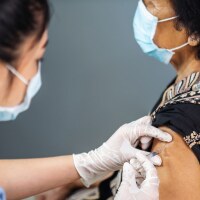Orange County Gets First Doses of COVID-19 Vaccine

SANTA ANA (CNS) - A Providence St. Joseph Hospital nurse was the first person in Orange County today to be vaccinated for COVID-19, shortly followed by other health care workers.
“It is a very special day to be here,” Providence St. Joseph CEO Dr. Jeremy Zoch said, noting that the vaccine's arrival is a much-needed relief after many difficult months.
Nurse Michael Lowman was the first to voluntarily receive the inoculation, followed by nurses Song Lee and Soledad Mathus, Dr. Paul Sheikewitz, and respiratory therapist Brian Sullivan, at Providence St. Joseph's Hospital in Orange. Nurse practitioner Christie Aiello administered the shots.
Applause broke out as Aiello gave Lowman a shot in the arm.
“It's a very special time,” Zoch said, to be giving shots to the hospital's employees who tirelessly treat coronavirus patients, often taking on extra shifts and skipping days off. “Today is the beginning ... We know from the doses we've got that with the next several weeks we'll be able to vaccinate all of our front-line caregivers working bedside.”
Zoch said he was encouraged by how eager his employees are to get vaccinated.
“We love that our caregivers, who know the science, are saying we want the vaccine,” he said. “That energy is really positive.”
The doses arrived Wednesday morning and were being administered within a few hours, Zoch said.
UC Irvine also received about 3,000 doses of the Pfizer vaccine Wednesday morning and began administering shots. The plan is to vaccinate 2,000 front line healthcare workers by Sunday.
UCI is expecting to receive the first doses of Moderna vaccine by next week if it is approved as expected this week.
Hoag Memorial Hospital Presbyterian in Newport Beach also received 1,950 doses Wednesday, said Dr. Stephanie Chao, Hoag's director of pharmacy services. The hospital plans to begin giving out shots at 6 a.m. Thursday, she said.
“It feels great,” Chao told City News Service. “I know there's a lot of work to be done still and this is just the beginning — but to get going on those vaccines, to get them safely in was oddly satisfying and pleasing. We have hope now.”
Chao said it is a tricky process to ready the vaccines for inoculation. Since Hoag does clinical studies it had the necessary deep-freeze unit to house the doses, but a larger freezer that can store 15 times more doses is on the way, Chao said.
The vaccine must be thawed out initially in a refrigerator before it is reconstituted into liquid form for vaccination, Chao said. The hospital has five sessions planned for Thursday to make sure the shots are spaced out and administered on time before they can expire, Chao said.
“Our goal is to vaccinate 600 healthcare workers,” Chao said. “We want to make sure they're all appointment-based so we don't waste any doses.”
The vaccines can be thawed out at room temperature faster, but it expires in two hours that way, Chao said. If it is thawed in the refrigerator then it can last for five days, she added.
Moderna's vaccine will require freezing, but it won't need a special deep freezer, she said.
Dr. Clayton Chau, the director of the Orange County Health Care Agency and county's chief health officer, said Pfizer's vaccine can be up to 88% effective if one receives just one of the two doses, but the booster shot makes it 95% effective.
Chao said it is important, however, to emphasize how critical the booster shot is to achieve herd immunity.
Chau said the county has received about 25,000 doses of Pfizer's vaccine and expect about 17,000 booster doses in about two weeks. If Moderna's vaccine is authorized this week then the county will receive about 32,000 doses of that, Chau said.
The county has about 200,000 healthcare workers and 12,000 first responders so many more vaccines are needed to cover them all, Chau said.
“I'm hopeful that by late February or March there will be enough vaccine for the general population,” Chau said.
Orange County's hospitals are struggling with a surge of new patients that have some hospitals such as St. Jude's in Fullerton overflowing with patients in its intensive care unit.
Zoch said he had to call his mother in Minnesota to tell her he couldn't come home for Christmas for the first time in decades. He encouraged the public to do the same and stay home for the holidays.
Zoch added his staff has a plan to expand if necessary by using space at neighboring Children's Hospital of Orange County.
“We're fortunate we have CHOC Children's next to us,” he said.
Top Image: Nurse Michael Lowman gets the first dose of the Pfizer BioNTech COVID-19 vaccine from nurse practitioner Christie Aiello at Providence St. Joseph Hospital in Orange, CA, on Dec. 16, 2020. | Jeff Gritchen/MediaNews Group/Orange County Register via Getty Images





